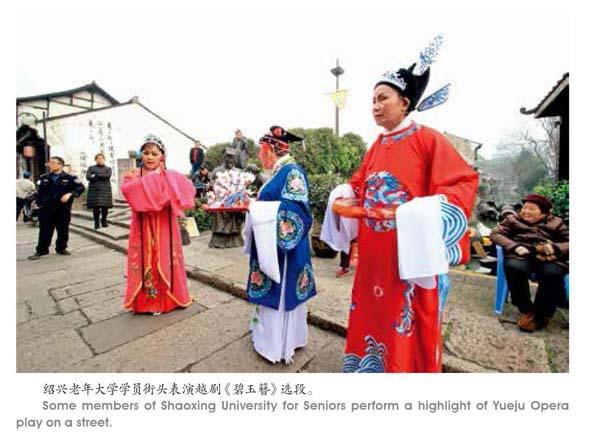戏上安昌
2020-08-14陈富强
陈富强



安昌是我的诞生地。那儿的每一块青石板,每一片黛瓦,每一条湿漉漉的弄堂,都塞满了我童年的记忆。
一
从文化地域上来划分,安昌所在地区流行绍剧和莲花落。
绍剧,中国传统戏曲剧种,原名“绍兴乱弹”,以高亢激越的唱腔、粗犷朴实的音乐、豪放洒脱的表演和文武兼备等特点形成独特的艺术风格。莲花落,绍兴一带的曲艺种类之一,形成之初以沿门说唱为主,此后又开始以绍兴方言说唱长篇书目,幽默风趣。
但安昌人却普遍偏爱越剧。我想这大约与安昌的地理环境、文化背景有一定的关系。安昌始建于北宋,从明朝中叶开始繁华,一直到晚清都是方圆数十里叫得响的集镇,而且它的建筑风格完全是明清的典范,小桥流水人家,粉墙黛瓦,雨廊骑楼,到处都是明清的痕迹。从一座拱桥,一根垂挂在桥边的枯藤;从一块石板,一棵石板缝里的小草;从一排屋檐,一片檐上的黑瓦,都写着安昌的沧海桑田。安昌人就是这样不慌不忙一路走来,说的是吴侬软语,吃的是稻麦菱藕,睡的是雕花木床,戴的是竹笠,穿的是蓑衣。他们已经习惯了舒缓的生活节奏,绍剧的高亢在他们听来有点过于激昂到稍微嘈杂,所以他们选择了越剧。越剧唱腔的清丽、委婉、抒情恰好与安昌人的生活习性相吻合。当然,他们也不排斥绍剧和莲花落,逢年过节,唱社戏的时候,戏台上,越剧、绍剧、莲花落各领风骚。
安昌离越剧的发源地嵊县不算太远,同属一个地区。说起嵊县的越剧,老一辈的安昌人总是津津乐道,他们能如数家珍地报出“越剧十姐妹”的姓名,以及她们都有一些什么代表作品,连哪个是唱小生,哪个是唱花旦也搞得清清楚楚,甚至连先后排名的顺序都不会颠倒,而且对戚雅仙、王文娟、金彩凤没能进入十姐妹之列一直耿耿于怀。
老辈的安昌人知道越剧好听,却未必晓得越剧是怎么来的。我为此专门去过嵊县,看过小城外的那条剡溪。嵊县山清水秀,唱越剧是最合适不过。一条美丽的剡溪穿城而过,水清得像玻璃透着溪底的卵石,溪畔的杨柳和芦苇就是站成一排一排的小城女子,随风而舞的芦苇叶子,好比是女子的长发在风中飘扬,她们站在黄昏的残霞中一齐亮开了嗓子咿咿呀呀地唱着,唱得溪水也放慢了流速,唱得西边的太阳也醉红了脸。
越剧的来由与“落地唱书”有关,它采用的是佛曲、宣卷、道情、莲花落等俗曲小调,唱的多是一些劝人为善,祝福长寿,多生贵子等吉利词句,这些唱词大多采自民间歌谣,语言质朴,想象奇特,易于在民间流传。在春秋战国时期,嵊县是越国的属地,所以人们把诞生于嵊县的戏剧剧种命名为越剧。越剧早期的一些长篇书目多是从传书、卷本、戏曲中移植改变过来的,比较著名的有《双珠凤》《珍珠塔》《玉蜻蜓》等。安昌人看到的越剧是以女子为主体的,其实,早期的越剧演员都是男子,到了20世纪30年代初,才由女子占领了越剧舞台,而且一发而不可收,群星闪耀,新秀辈出,保留曲目都能登得上大雅之堂。这些曲目在古镇盛演不衰,大戏如《梁山伯与祝英台》《西厢记》《红楼梦》《孔雀东南飞》《汉宫怨》等,都令古镇人百看不厌,百听不烦。
二
但也不是经常能有大戏可看。能演大戏的一般是正规的剧团,早先的安昌没有自己的正规剧团,要看大戏就得去城里,去城里毕竟要花费,门票不说,来回的车马费也是一笔不小的开支,还得吃一顿饭。就只好将就,看社戏是一个最好的办法。
安昌人看社戏与鲁迅笔下的描述大致相同,也是四乡八村的越剧爱好者赶场子,哪儿演就往哪儿赶。安昌演社戏请的是“草台班子”,也就是凑拢班子,跟现在的明星走穴有点类似,也是东来一个,西来一伙,你唱老生,我演花旦,他做琴師,凑成一个剧组,带上服装、道具就开路。
戏台就临时搭一个,找一块空旷的晒场,用毛竹、木板、塑料布搭起一个戏台来,人往台上一站,台子会吱吱地响,搭台子的人说不要紧,再在前后左右撑几根毛竹就牢固了。撑了毛竹,戏台果然就结实了。晒场总是临河,河上总是有桥,演戏的时候,晒场上的人挤得站不下,就跳进泊在河里的船舱,不光船舱,连桥上也都是人了。实在看不见戏台子上演员的,就走到戏台后面去,看不见演员,但听得见演员唱戏。
草台班子演的戏为啥叫社戏?上了年纪读过私塾的老辈人说这个就说来话长了。老底子的人说“锣鼓响,脚底痒”,逢年过节再穷也要演几场社戏乐一乐。这个社戏的社是土地神。古时候,人们把土地分为山林、川泽、丘陵、坟衍、原隰(音为xí),称作五土,社就是五土的总神。而古时候,又称稻、黍、稷、麦、菽为五谷,稷呢,是五谷的总神。谷赖土而长,社可代表社稷,人非土不立,非谷不食,社稷可是生命的根本。所以,古代要筑社稷坛来祭社稷神,民间则以祭社,后来又发展到以演戏来祭社,以此来祈求阖村平安。
社戏演的一般都是折子戏,大戏通常不演,一是演出的报酬,二是演员的功底,这些都是问题。演社戏的经费有好几种来源,有村子里出的,有村子里的有钱人出的,也有村民自愿凑钱的。到村子里演的演员多数是自学成才,没有经过专业培训,大戏唱不下来,顶多唱唱大戏里面的某一部分,比方说像《红楼梦》里的“黛玉葬花”“宝玉哭灵”,或者说像《梁山伯与祝英台》里的“十八相送”。如果村子里提出要演大戏,草台班子就会提出比较高的价码,安昌人就会因接受不了而作罢。
社戏除演越剧,也有绍剧和莲花落的专场。虽然观众没有看越剧的多,但也是场场爆满。安昌人对绍剧演员和莲花落演员没有像对越剧演员那么熟悉,但也了然于心。尤其可贵的是莲花落的许多段子都是艺人自己创作的,取材于安昌人耳熟能详的生活,演来就格外亲切。有一出叫《九斤姑娘》的戏,唱的是一个聪明的姑娘叫九斤如何有智慧。她能回答各种稀奇古怪的问题,比方说“半夜三更要紧桶”是什么桶?九斤就会回答是马桶。这是形象的民间语言。据说这出戏的发源地就离安昌镇不远,也是一座古镇,临河一排木板房,河上有一座一座石拱桥。许多安昌人都去看过那个诞生了《九斤姑娘》的地方,看后都显得有点不以为然,认为那个地方比安昌好不到哪里去,安昌也完全可以出一个九斤姑娘。
我離开安昌很多年,但相对安昌的历史不过像小河里的一滴水。我曾经走过的廊檐下依旧有石雕的镂花格子窗。那些拱桥的桥面是越来越光滑了。只是不晓得临河的窗子里还会不会飘出女子婉丽的唱腔?逢年过节的时候晒场上还演不演社戏?如果演,是单演越剧,还是和绍剧、莲花落一起演?或者是各自搭起一个舞台铿铿锵锵独自演?还演不演《男吊》和《女吊》?还演《无常》吗?
我听得见安昌的呼吸声,那是来自心底的一种怀念,一种至死也不忘的故乡情结。看来,我得回安昌一趟了,去那条在明朝就铺好的青石板街道上走一走了。
Ancient Anchang:Regional Operas in Memory
By Chen Fuqiang
Anchang is my hometown. It is part of Shaoxing, a city of history and culture in eastern Zhejiang. In 895, Qian Liu defeated warlord Dong Chang and brought peace to the river town. The town was renamed Anchang. And Anchang it has been since then. I was born there. Every inch of the ancient town is in my childhood memories.
According to some cultural geographers, Anchang has every reason to be in the sphere of inference of Shaoju Opera and Lotus Storytelling, two forms of regional popular entertainment in Shaoxing. Shaoju Opera features high-pitch loud singing and martial art stunts, a style often seen in the north of China. Lotus Storytelling used to be a street performance. A street artist of Lotus Storytelling went from door to door. If engaged, a performer would tell a story in Shaoxing dialect. In the repertoire of Lotus Storytelling are some lengthy stories. However, people in Anchang prefer Yueju Opera, which is also a regional entertainment of Shaoxing.
This preference probably is associated with the history of the river town. Though it has a history of more than 1,000 years, it was not until the mid-phase of the Ming Dynasty (1368-1644) that the town thrived. And its prosperity lasted until the last years of the Qing (1644-1911). The houses in town are all in the architectural styles of the Ming and the Qing. One can easily see the perfect examples of the past architecture: arch bridges, flagstone streets and roads, houses with blackish roof tiles. Residents speak a dialect that is soft. In their houses you can find beds ornately decorated with fine woodcarving. Their staple food is rice and lotus roots. They are quite comfortable with this tranquil and slow pace of life that they somewhat dislike the Shaoju Opera as they find it too loud and too noisy. So they like Yueju Opera, which is lyrical, serene, and soft. Their preference does not mean that they dont enjoy Shaoju Opera and Lotus Storytelling performances. During the Spring Festival and folk festivities, all three entertainments are available in Anchang.
After all, Anchang is not far from Shengxian County, where Yueju Opera originated over 100 years ago. Seniors in Anchang know the names of Yueju Opera stars that went from their villages to Shanghai and made it there. The old generation in Anchang loves Yueju Opera but they are not clear about the genesis of this regional opera. I once visited Shengxian to understand the operas deep roots. The cradle of Yueju Opera is scenic. The arias of the opera came from various local sources such as Buddhism singing, ballad singing and storytelling. The lyrics were mostly from folk songs and poems, simple and imaginative, easy to be memorized and repeated by rural theatergoers. Some early plays in the history of Yueju Opera repertoire were adapted from local scripts composed by grassroots folk artists. In early years of the Yueju Opera, the opera plays were performed by men only. It was in the early 1930s that women became dominant performers and there appeared all-women performances and all-women troupes. Plays in Yueju Opera repertoire were refined again and again until they became classics. People in Anchang have been in love with Yueju Opera since then.
In good old days, theatergoers in Anchang did not have a theater to go to. A trip to theaters in Shaoxing would cost a small fortune. Most theatergoers in Anchang chose to watch village opera shows often staged by rural artists who came together to hold such a show together. These artists often banded together and went on a road show as a temporary troupe when farm work wasnt so busy. In villages, a makeshift stage could be hastily set up with bamboo poles, wood boards and plastic sheets on a riverside ground for drying rice. Without bamboo poles to reinforce the stage from sides, a stage would shake and squeak. Such an opera show always attracted a large crowd including theatergoers from neighboring villages. Some people watched an opera show from boats moored in the river by the show ground. Some watched the show from a bridge a little bit afar from the stage. Such an opera show usually occurred during a ceremony which was held in honor of local gods. Most performers were amateurs.
I have not seen such a show in Anchang for a long while. I can still hear the breathing of my hometown in my heart. I think I need to go back for a visit, for a long stroll in flagstone streets built in the Ming Dynasty.
